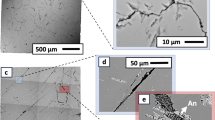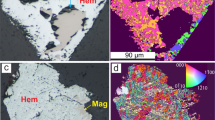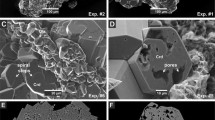Abstract
Reactive fluid flow can control the mineralogical, mechanical and chemical evolution of the Earth’s crust. When rocks are exposed to differential stresses (i.e., vertical stress ≠ horizontal stress ≠ pore-fluid pressure (Pf)) during reactive fluid flow, effective pressure is usually assumed to control the overall reaction process. Here, we show that fluid pressure can play an important role in mineral replacement reactions. We conducted experiments in which calcite (CaCO3) grains (fraction size 53–150 µm) reacted with a Mg-rich solution at ~ 200 °C both in a closed system and under reactive fluid flow conditions with different fluid flow rates and fluid pore pressures, but with similar confining pressure (σn = 10 or 20 MPa) and effective pressure (Pe). Under closed system, vapor-saturated pressures, the magnesite formed with large pores between the magnesite and the calcite. In the open system flow-through experiments, however, brucite (Mg(OH)2) or magnesite (MgCO3) formed, depending on pore-fluid pressure. The main reaction product was brucite at low pore-fluid pressure (0.2 MPa), but magnesite at higher pore-fluid pressures (≥ 1 MPa). Calcite dissolution and precipitation of the product mineral increased concomitantly with flow rate, but the flow rate did not affect the nature of the products. The permeability of the reacting rock was related to the reaction pathway, i.e. the nature of the products. Magnesite replaced the pristine calcite in a pseudomorphic manner, and mantled the pristine calcite with 10–100 µm wide pores. In contrast, tabular and/or platy brucite blocked the porosity and resulted in a decrease in permeability. Our results show that the pore-fluid pressure can be a significant parameter controlling the reaction products and reaction processes in volatile-rich (e.g., CO2, HCl, H2S and SO2) systems at conditions close to phase separation; these conditions occur for example in epithermal and porphyry hydrothermal systems, and in carbonate-replacement and some metamorphic environments.









Similar content being viewed by others
References
Altree-Williams A, Pring A, Ngothai Y, Brugger J (2015) Textural and compositional complexities resulting from coupled dissolution–reprecipitation reactions in geomaterials. Earth Sci Rev 150:628–651
Altree-Williams A, Pring A, Ngothai Y, Brugger J (2017) The carbonatation of anhydrite: kinetics and reaction pathways. ACS Earth Space Chem 1:89–100
Arvidson RS, Mackenzie FT (1999) The dolomite problem; control of precipitation kinetics by temperature and saturation state. Am J Sci 299:257–288
Bethke CM (1986) Inverse hydrologic analysis of the distribution and origin of Gulf Coast-type geopressured zones. J Geophys Res 91:6535–6545
Bethke CM (2007) Geochemical and biogeochemical reaction modeling. Cambridge University Press, Cambridge
Bish DL, Post JE (1993) Quantitative mineralogical analysis using the Rietveld full-pattern fitting method. Am Miner 78:932–940
Brace W (1972) Pore pressure in geophysics, vol 16. American Geophysical Union Geophysical Monograph Series, Washington, pp 265–273
Cartwright I, Weaver TR (1993) Fluid-rock interaction between syenites and marbles at Stephen Cross Quarry, Québec, Canada: petrological and stable isotope data. Contrib Miner Petrol 113:533–544
Chang B, Li C, Liu D, Foster I, Tripati A, Lloyd M.K, Maradiaga I, Luo G, An Z, She Z, Xie S (2020) Massive formation of early diagenetic dolomite in the Ediacaran ocean: constraints on the “dolomite problem”. Proceedings of the National Academy of Sciences 117(25):14005–14014. https://doi.org/10.1073/pnas.1916673117
Coelho AA, Evans J, Evans I, Kern A, Parsons S (2011) The TOPAS symbolic computation system. Powder Diffr 26:S22–S25
De Wolff PM, Walter-Levy L (1953) The crystal structure of Mg2(OH)3(Cl, Br).4H2O. Acta Crystallogr A 6:40–44
Duan Z, Sun R, Zhu C, Chou IM (2006) An improved model for the calculation of CO2 solubility in aqueous solutions containing Na+, K+, Ca2+, Mg2+, Cl−, and SO42−. Mar Chem 98:131–139
Etschmann B, Brugger J, Pearce M, Ta C, Brautigan D, Jung M, Pring A (2014) Grain boundaries as microreactors during reactive fluid flow: experimental dolomitization of a calcite marble. Contrib Miner Petrol 168:1045
Ferry JM, Rumble D III (1997) Formation and destruction of periclase by fluid flow in two contact aureoles. Contrib Miner Petrol 128:313–334
Gebauer D, Kellermeier M, Gale JD, Bergström L, Cölfen H (2014) Pre-nucleation clusters as solute precursors in crystallization. Chem Soc Rev 43:2348–2371
Heinrich W (2007) Fluid immiscibility in metamorphic rocks. Rev Mineral Geochem 65:389–430
Hellmann R, Renders PJ, Gratier J-P, Guiguet R (2002) Experimental pressure solution compaction of chalk in aqueous solutions. Part 1. Deformation behavior and chemistry. Water-rock Interact Ore Deposit Environ Geochem 7:129–152
Huang F, Sverjensky DA (2019) Extended Deep Earth Water Model for predicting major element mantle metasomatism. Geochim Cosmochim Acta 254:192–230
Jonas L, Müller T, Dohmen R, Baumgartner L, Putlitz B (2015) Transport-controlled hydrothermal replacement of calcite by Mg-carbonates. Geology 43:779–782
Jonas L, Müller T, Dohmen R, Immenhauser A, Putlitz B (2017) Hydrothermal replacement of biogenic and abiogenic aragonite by Mg-carbonates–Relation between textural control on effective element fluxes and resulting carbonate phase. Geochim Cosmochim Acta 196:289–306
Kaczmarek SE, Sibley DF (2011) On the evolution of dolomite stoichiometry and cation order during high-temperature synthesis experiments: an alternative model for the geochemical evolution of natural dolomites. Sed Geol 240:30–40
Kaczmarek SE, Thornton BP (2017) The effect of temperature on stoichiometry, cation ordering, and reaction rate in high-temperature dolomitization experiments. Chem Geol 468:32–41
Katz A, Matthews A (1977) The dolomitization of CaCO3: an experimental study at 252–295˚C. Geochim Cosmochim Acta 41:297–308
Kessels LA, Sibley DF, Nordeng SH (2000) Nanotopography of synthetic and natural dolomite crystals. Sedimentology 47:173–186
Land LS (1998) Failure to precipitate dolomite at 25 ˚C from dilute solution despite 1000-fold oversaturation after 32 years. Aquat Geochem 4:361–368
Li Z, Chau CK (2007) Influence of molar ratios on properties of magnesium oxychloride cement. Cem Concr Res 37:866–870
Lojka M, Jiříčková A, Lauermannová A-M, Pavlíková M, Pavlík Z, Jankovský O (2019) Kinetics of formation and thermal stability of Mg2(OH)3Cl.4H2O. In: AIP Conference Proceedings, Vol 2170, No 1. AIP Publishing LLC, p 020009. https://doi.org/10.1063/1.5132728
Matter JM, Kelemen PB (2009) Permanent storage of carbon dioxide in geological reservoirs by mineral carbonation. Nat Geosci 2:837–841
Mei Y, Liu W, Sherman DM, Brugger J (2014) Metal complexation and ion hydration in low density hydrothermal fluids: ab initio molecular dynamics simulation of Cu (I) and Au (I) in chloride solutions (25–1000 C, 1–5000 bar). Geochim Cosmochim Acta 131:196–212
Morrissey LJ, Tomkins AG (2020) Evaporite-bearing orogenic belts produce ligand-rich and diverse metamorphic fluids. Geochim Cosmochim Acta 275:163–187
Müller T, Baumgartner LP, Foster CT Jr, Vennemann TW (2004) Metastable prograde mineral reactions in contact aureoles. Geology 32:821–824
Oh KD, Morikawa H, Iwai SI, Aoki H (1973) The crystal structure of magnesite. Am Miner 58:1029–1033
Okamoto A, Shimizu H (2015) Contrasting fracture patterns induced by volume-increasing and-decreasing reactions: implications for the progress of metamorphic reactions. Earth Planet Sci Lett 417:9–18
Paquette J, Reeder RJ (1990) Single-crystal X-ray structure refinements of two biogenic magnesian calcite crystals. Am Miner 75:1151–1158
Parkhurst DL, Appelo CAJ (2013) Description of input and examples for PHREEQC version 3: a computer program for speciation, batch-reaction, one-dimensional transport, and inverse geochemical calculations, No 6-A43. US Geological Survey. https://doi.org/10.3133/tm6A43
Poonoosamy J, Wanner C, Epping PA, Águila JF, Samper J, Montenegro L, Xie M, Su D, Mayer KU, Mäder U, Van Loon LR (2018) Benchmarking of reactive transport codes for 2D simulations with mineral dissolution–precipitation reactions and feedback on transport parameters. Comput Geosci. https://doi.org/10.1007/s10596-018-9793-x
Poonoosamy J, Westerwalbesloh C, Deissmann G, Mahrous M, Curti E, Churakov SV, Klinkenberg M, Kohlheyer D, von Lieres E, Bosbach D, Prasianakis NI (2019) A microfluidic experiment and pore scale modelling diagnostics for assessing mineral precipitation and dissolution in confined spaces. Chem Geol 528:119264
Popov YA, Pevzner SL, Pimenov VP, Romushkevich RA (1999) New geothermal data from the Kola superdeep well SG-3. Tectonophysics 306:345–366
Prasianakis NI, Curti E, Kosakowski G, Poonoosamy J, Churakov SV (2017) Deciphering pore-level precipitation mechanisms. Sci Rep 7:1–9
Putnis A (2002) Mineral replacement reactions: from macroscopic observations to microscopic mechanisms. Mineral Mag 66:689–708
Putnis A (2009) Mineral replacement reactions. Rev Mineral Geochem 70:87–124
Putnis A (2014) Why mineral interfaces matter. Science 343:1441–1442
Putnis A, Austrheim H (2010) Fluid-induced processes: metasomatism and metamorphism. Geofluids 10:254–269
Putnis A, John T (2010) Replacement processes in the Earth’s crust. Elements 6:159–164
Richards JP (2011) Magmatic to hydrothermal metal fluxes in convergent and collided margins. Ore Geol Rev 40:1–26
Robin PYF (1973) Note on effective pressure. J Geophys Res 78:2434–2437
Rodriguez-Navarro C, Burgos-Cara A, Di Lorenzo F, Ruiz-Agudo E, Elert K (2020) Nonclassical crystallization of calcium hydroxide via amorphous precursors and the role of additives. Cryst Growth Des 20:4418–4432
Roehl PO, Choquette PW (2012) Carbonate petroleum reservoirs. Springer Science & Business Media, Berlin
Seigneur N, Mayer KU, Steefel CI (2019) Reactive transport in evolving porous media. Rev Mineral Geochem 85:197–238
Sibley DF, Nordeng SH, Borkowski ML (1994) Dolomitization kinetics of hydrothermal bombs and natural settings. J Sediment Res 64:630–637
Simandl GJ, Paradis S, Irvine M (2007) Brucite-industrial mineral with a future. Geosci Can 34(2):57–64. https://journals.lib.unb.ca/index.php/GC/article/view/10236
Urwongse L, Sorrell CA (1980) The system MgO–MgCl2–H2O at 23 ˚C. J Am Ceram Soc 63:501–504
Vandeginste V, Snell O, Hall MR, Steer E, Vandeginste A (2019) Acceleration of dolomitization by zinc in saline waters. Nat Commun 10:1851
Vitaliano CJ, Callaghan E (1956) Geologic map of the Gabbs magnesite and brucite deposits, Nye County, Nevada. US Geological Survey, Carson
Xia F, Brugger J, Chen G, Ngothai Y, O’Neill B, Putnis A, Pring A (2009) Mechanism and kinetics of pseudomorphic mineral replacement reactions: a case study of the replacement of pentlandite by violarite. Geochim Cosmochim Acta 73:1945–1969
Xu J, Yan C, Zhang F, Konishi H, Xu H, Teng HH (2013) Testing the cation-hydration effect on the crystallization of Ca–Mg–CO3 systems. Proc Natl Acad Sci 110:17750–17755
Yapparova A, Gabellone T, Whitaker F, Kulik DA, Matthäi SK (2017) Reactive transport modelling of dolomitisation using the new csmp++ gem coupled code: Governing equations, solution method and benchmarking results. Transp Porous Media 117:385–413
Zang A, Stephansson O (2009) Stress field of the earth’s crust. Springer Science & Business Media, Berlin
Zhang X, Spiers CJ, Peach CJ (2011) Effects of pore fluid flow and chemistry on compaction creep of calcite by pressure solution at 150 ˚C. Geofluids 11:108–122
Zhao J, Brugger J, Chen G, Ngothai Y, Pring A (2014) Experimental study of the formation of chalcopyrite and bornite via the sulfidation of hematite: mineral replacements with a large volume increase. Am Miner 99:343–354
Zhao J, Brugger J, Pring A (2019) Mechanism and kinetics of hydrothermal replacement of magnetite by hematite. Geosci Front 10:29–41
Zhong X, Vrijmoed JC, Tajčmanová L (2017) Effect of grain-scale pressure variations on garnet growth: a numerical approach. J Metamorph Geol 35:19–33
Zigan F, Rothbauer R (1967) Neutronenbeugungsmessungen am brucit. Neues Jahrbuch für Mineralogie Monatshefte 1967:137–214
Acknowledgements
We thank the Australian Research Council (Grant DP170101893 to Joël Brugger) for supporting this research and Monash University for offering a scholarship during Gan’s Ph.D research. We acknowledge use of the facilities and the assistance of Xiya Fang at the Monash Centre for Electron Microscopy, Jisheng Ma from Monash X-ray platform and Nick Wilson from the Commonwealth Scientific and Industrial Research Organisation (CSIRO) Clayton. We thank Thibaut Gasst and others from Core Laboratories for helping build up and offer training for the tri-axial flow-through apparatus. We are grateful to two anonymous reviewers for helpful comments that improved the manuscript, and to associate editor Daniela Rubatto for handling this manuscript.
Author information
Authors and Affiliations
Corresponding author
Additional information
Communicated by Daniela Rubatto.
Publisher's Note
Springer Nature remains neutral with regard to jurisdictional claims in published maps and institutional affiliations.
Electronic supplementary material
Below is the link to the electronic supplementary material.
Rights and permissions
About this article
Cite this article
Duan, G., Brugger, J., Etschmann, B. et al. Formation of Mg-carbonates and Mg-hydroxides via calcite replacement controlled by fluid pressure. Contrib Mineral Petrol 176, 1 (2021). https://doi.org/10.1007/s00410-020-01755-4
Received:
Accepted:
Published:
DOI: https://doi.org/10.1007/s00410-020-01755-4




